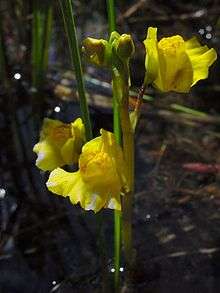Utricularia macrorhiza
Utricularia macrorhiza, the common bladderwort,[1] is a perennial suspended aquatic carnivorous plant that belongs to the genus Utricularia. U. macrorhiza is native to North America and eastern temperate Asia.[2]
| Utricularia macrorhiza | |
|---|---|
 | |
| Scientific classification | |
| Kingdom: | Plantae |
| Clade: | Tracheophytes |
| Clade: | Angiosperms |
| Clade: | Eudicots |
| Clade: | Asterids |
| Order: | Lamiales |
| Family: | Lentibulariaceae |
| Genus: | Utricularia |
| Subgenus: | Utricularia subg. Utricularia |
| Section: | Utricularia sect. Utricularia |
| Species: | U. macrorhiza |
| Binomial name | |
| Utricularia macrorhiza | |
| Synonyms | |
| |
Description
U. macrorhiza is a floating plant with six to twenty large, bilaterally symmetrical, yellow flowers that appear in June, July, and August, and are held on an erect stem.[3] U. macrorhiza is distinguished from other similar species by its flowers, which are larger than those found on any other bladderwort.[3]
The bladders which give common bladderwort its name are used to trap and consume prey.[3] Small organisms trigger the hairs on the pores of the bladder as they brush against it, causing the pore to open inward, allowing a rush of water into the bladder which pulls the prey in as well.[3] The pore immediately closes behind the prey, which is then digested by enzymes within the bladder.[3] The process of trapping the prey from opening to closing the pore takes place in 0.002 seconds.[3] If large prey becomes stuck in the pore, the prey is digested by the enzymes bit by bit until the pore closes again.[3]
Distribution
In North America, U. macrorhiza is found throughout the United States and Canada.[1][3] In this range, it is found mostly in ponds and lakes, but also in slow-moving streams and rivers.[3] It shares the northern half of its range with a similar, related species, U. minor, lesser bladderwort.[1]
See also
References
| Wikimedia Commons has media related to Utricularia macrorhiza. |
- "Utricularia macrorhiza". Natural Resources Conservation Service PLANTS Database. USDA. Retrieved 2008-12-28.
- Taylor, Peter. (1989). The genus Utricularia - a taxonomic monograph. Kew Bulletin Additional Series XIV: London.
- "Lady Bird Johnson Wildflower Center - The University of Texas at Austin". www.wildflower.org. Retrieved 2018-10-16.